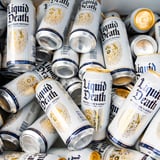A Nutrition Breakdown of Liquid Death's Products

While some may argue that the water market is, ahem, oversaturated, Liquid Death still manages to stand out. The metal (in material and aesthetic) cans of water have taken the H2O market by storm over the past few years. Today, over 100,000 retailers sells this drink, and they're beloved by sober-curious folks (who may want to hold something that won't stand out in a bar or music festival environment), environmentalists who are limiting their plastic use, and generally thirsty people alike.
As a registered dietitian, I'm committed to staying informed about food and beverage trends, always doing my research to determine whether this or that viral product is a beneficial addition to a healthy lifestyle or best left on the grocery shelves. And given the widespread popularity of Liquid Death, its unique marketing and the fact that it's so often sold in the same spaces as alcohol or energy drinks, I've frequently been asked about its health implications - and if Liquid Death is really just water, or if there's something more lurking in those cans. Here's what to know.
What Is Liquid Death, Exactly?
Liquid Death is not a potion from a medieval alchemy lab, nor is it a sinister substance from a horror movie. It's actually just water, served in the kind of tallboy cans that are usually reserved for beers, giving hydration a hardcore makeover that's both edgy and eco-friendly. Imagine cracking open a can, expecting the bitter taste of an IPA, but instead, you're greeted by the crisp, refreshing splash of mountain water. It's a plot twist in a can, designed to "murder" your thirst (get it?).
That said, the Liquid Death product line has expanded. These days, Liquid Death has still and sparkling varieties, and the latter comes in some cheeky-named flavors, like Cherry Obituary and Severed Lime. The newest addition to the Liquid Death fam include iced teas made with agave and vitamins and "Death Dust," which is their version of an electrolyte mix.
The branding of Liquid Death might make one think it's something extreme or dangerous, but it's really all in good fun – promoting a healthy lifestyle with a twist of humor and rebellion against plastic pollution. The cans are also recyclable, making them a great option in the fight against plastic waste.
Is Liquid Death Good For You?
As a dietitian, I can unequivocally say that yes, drinking plain or sparkling water is good for you, and therefore yes, the cans of still or sparkling Liquid Death are good for you. Both are calorie-free, sugar-free, and free from any preservatives. You'll have a tough time finding a registered dietitian, or anyone who works in the health and wellness space, to be against any product that may help people support their hydration status, especially since 75 percent of Americans are chronically dehydrated, which can cause problems ranging from brain fog to kidney health concerns.
The only thing to call out about the unflavored bubbly water is that in general, drinking too much sparkling water can cause bloating in some people - so keep that in mind if you have a sensitive stomach. (That said, Liquid Death claims to have "slightly less carbonation" and a less bitter taste.)
But Liquid Death's flavored sparkling waters, iced teas, and electrolyte powder do contain other ingredients. Here are some details to keep in mind when you're reaching for those products.
Liquid Death Flavored Sparkling Water
The Liquid Death Flavored Sparkling Waters are made with "natural flavors" and agave nectar, and contain four grams of added sugar per serving. That's not a lot, but people who are limiting their added sugar intake should be aware of this when consuming the drink.
Liquid Death Iced Teas
The Liquid Death Iced Tea varieties are made with green or black tea, agave, and a boost of B vitamins, including B6 and B12; one also has lemon juice concentrate. Each serving contains six grams of sugar and 30 mg of caffeine. Again, for most people, when consumed in moderate quantities, those numbers won't be problematic. But anyone who's limiting their sugar or caffeine intake, or are sensitive to either ingredient, should be aware of the nutrition label before consuming.
Liquid Death Death Dust
Like other electrolyte mixes, Liquid Death Death Dust, which is meant to be mixed with a glass of water, contains sodium and potassium to help support hydration status. It also contains sugar - eight grams per serving. Glucose can help the body absorb electrolytes like calcium, which is why so many electrolyte mixes contain it. But if you're not exercising intensely, you may not necessarily need the extra oomph electrolyte packets offer; a plain glass (or can) or water is hydration enough. So again, if you're limiting your intake of added sugar, be aware that Death Dust will add some to your diet.
Is Liquid Death Worth Drinking?
If you're trying to drink more water, limit your plastic use, and, frankly, look cool in the process, then Liquid Death is certainly worth drinking. While the original variety doesn't offer any additional nutritional benefits to plain old H2O, it does hit differently when drinking water out of a can versus a glass, potentially making it more appealing to drink. And according to recent data, at least 75 percent of us should cheers to that!
Lauren Manaker is an award-winning registered dietitian and freelance writer who is passionate about providing evidence-based nutrition information in a fun and interesting way
Welcome to Billionaire Club Co LLC, your gateway to a brand-new social media experience! Sign up today and dive into over 10,000 fresh daily articles and videos curated just for your enjoyment. Enjoy the ad free experience, unlimited content interactions, and get that coveted blue check verification—all for just $1 a month!
Account Frozen
Your account is frozen. You can still view content but cannot interact with it.
Please go to your settings to update your account status.
Open Profile Settings